This post may contain affiliate links. Please read our disclosure policy.
These Gluten free wonton wrappers are the perfect alternative to traditional wrappers. All you need are white rice flour, starch, water, salt, and oil. This vegan recipe uses simple, healthy ingredients—no gums, psyllium husks, or other hard-to-find items!
Learn to make perfectly smooth, paper-thin wonton wrappers using water, tapioca starch, white rice flour, salt, and oil. It was a labor of love to create this recipe, but it’s so worth it! Use this dough in my shrimp wontons, gyoza, dumplings, egg rolls, and more!
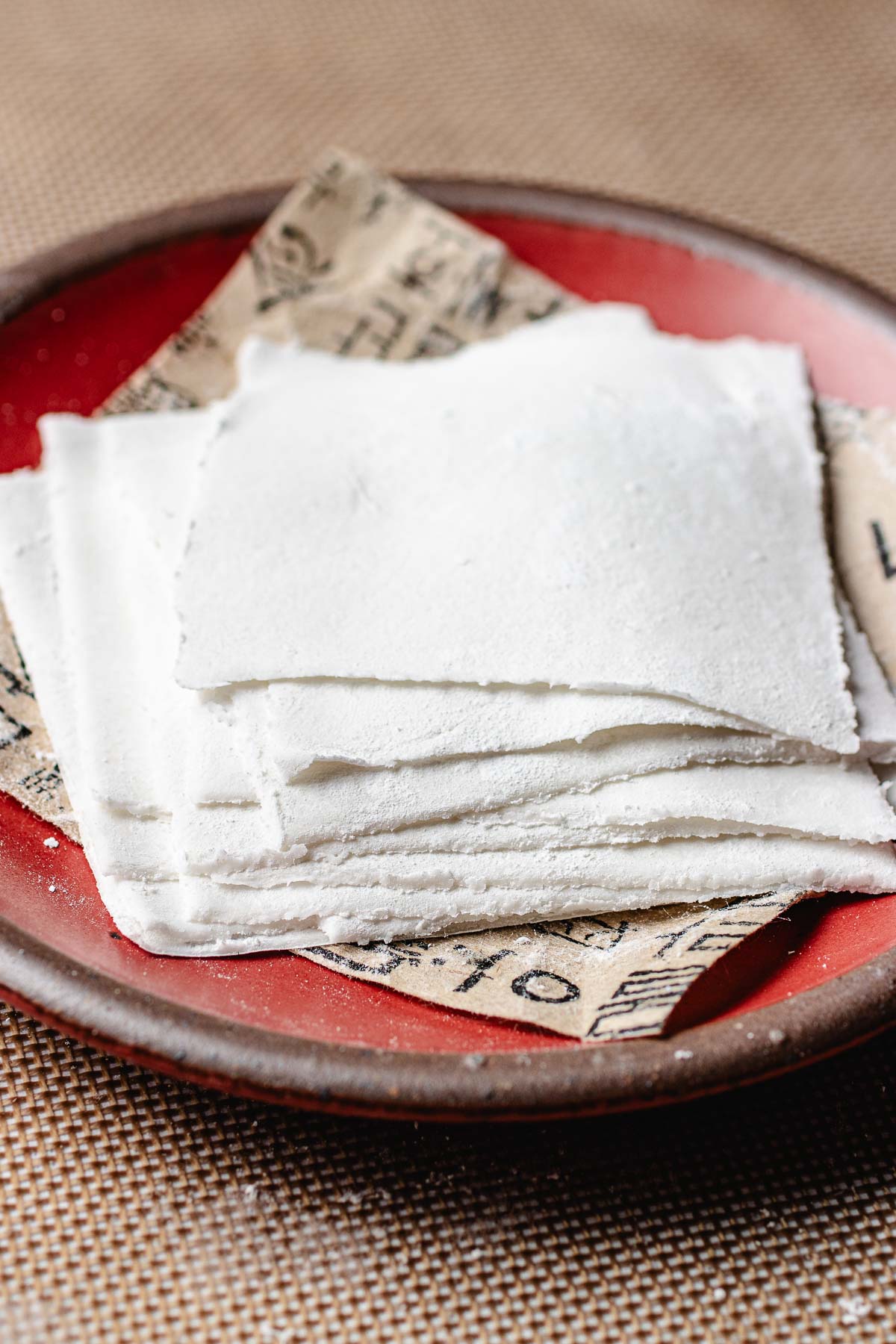
Table of Contents
- Ingredients for wonton wrappers gluten free
- Thai white rice flour vs. regular white rice flour
- How to make gluten free wonton wrappers
- How to make ahead, store, and cook
- How to use gluten free wonton wraps
- Tips for success
- FAQs
- More dumplings and egg roll recipes you might like
- Gluten free wonton wrappers recipe
Ingredients for wonton wrappers gluten free
I created this recipe using healthy, accessible ingredients—no xanthan gum, potato starch, or psyllium husks are required. It is very important that you use the same brands of these ingredients and that they are measured accurately. Changing the amounts or brands of gluten free flours or using an all-purpose gluten-free flour blend will drastically affect your results.
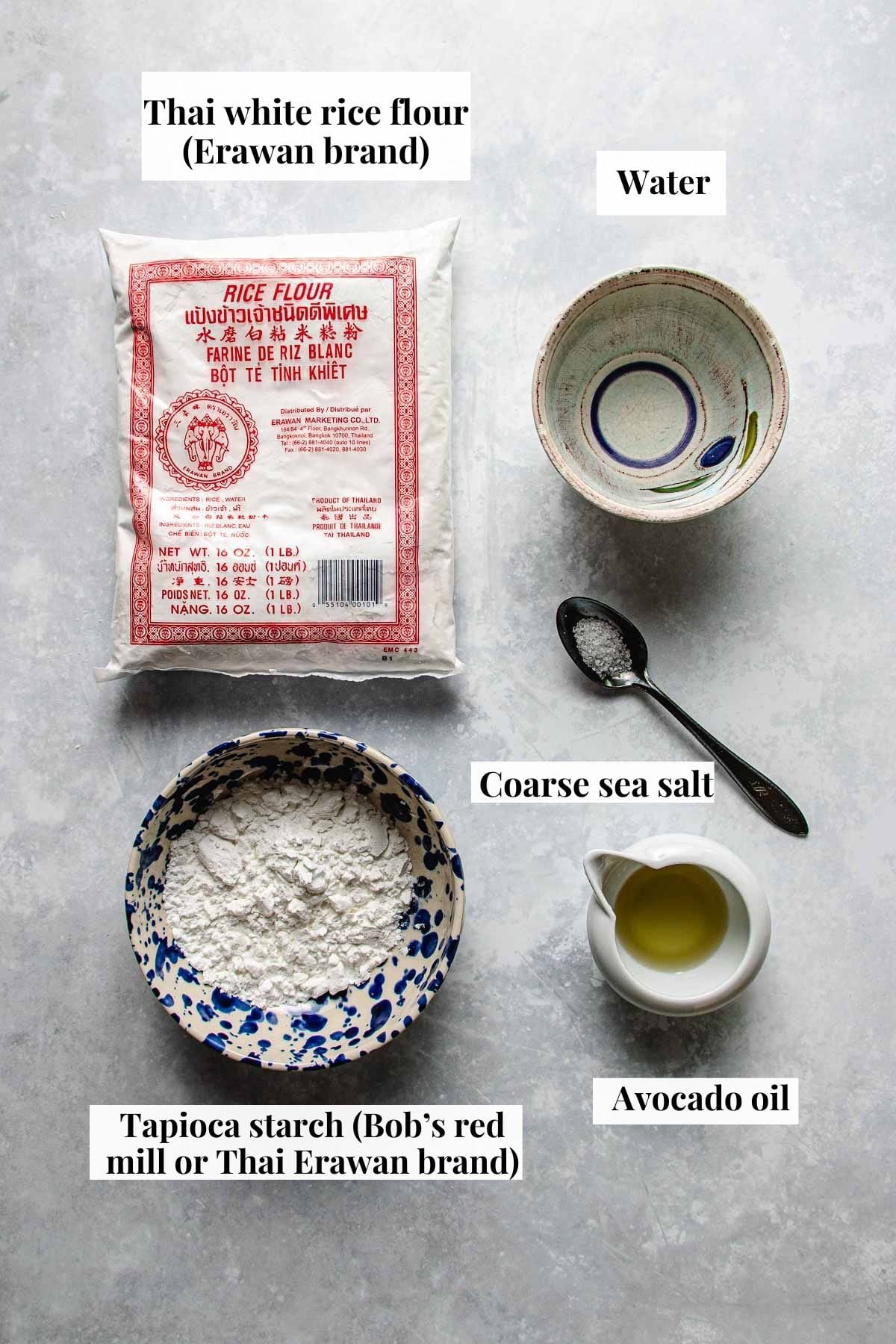
Save This Recipe
Ingredients:
- Water: It’s very important that you use the right amount of water. Use a measuring cup with milliliters to be precise. Measure 80 ml of room-temperature water plus 4 ml of warm water to set aside.
- Tapioca starch: Use Bob’s Redmill brand and use a scale to measure 50 grams.
- Thai rice flour: Use a scale to measure 50 grams of flour and set aside a small amount for dusting. Be sure to use wet-milled Thai rice flour. I use Erawan Thai rice flour.
- Coarse sea salt
- Avocado oil: You can also use rice bran oil.
- Turmeric powder (optional): Use turmeric powder if you want your wrappers to be yellow in color. This is totally optional.

Tools:
- Liquid measuring cup (with millimeter quantity)
- Large non-stick silicone pastry mat
- Rolling pin
- Weight scale
Thai white rice flour vs. regular white rice flour
For this recipe, use Thai white rice flour made by the brand Erawan. Look for packaging with 3 elephant heads on the front in red lettering. You can find it at Asian grocery stores or Amazon online.
The main difference between Thai and regular rice flour is the milling method, which affects the texture.
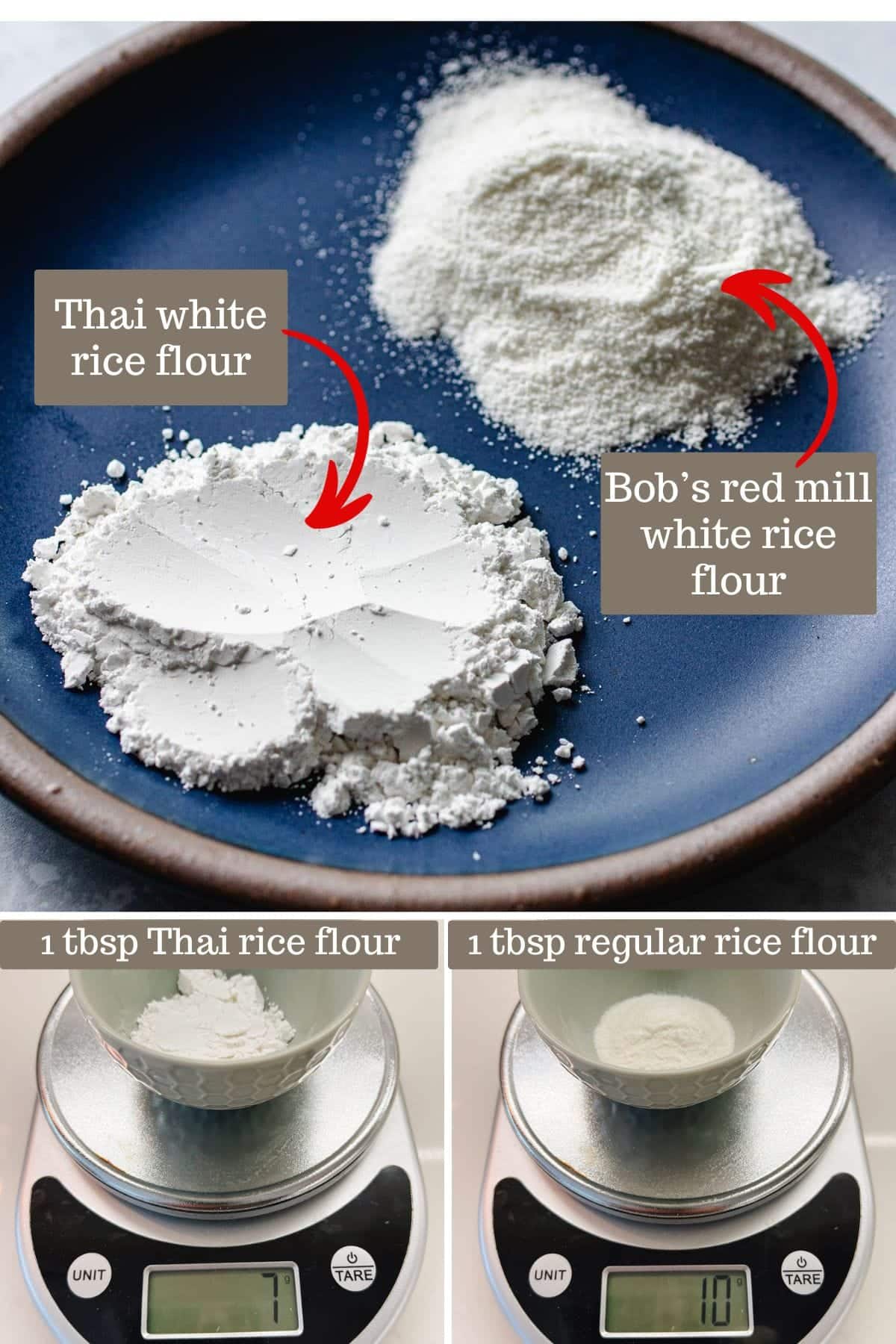
Thai rice flour is made from wet-milled rice. The rice grains are soaked before being ground into a super fine, silky powder.
Regular rice flour like Bob’s Red Mill is made from dry-milled rice. The grains are ground without soaking first, giving it a coarser texture.
One tablespoon of wet-milled Thai rice flour weighs about 7 grams. One tablespoon of dry-milled regular rice flour weighs about 10 grams. The Thai flour is lighter and rehydrates faster. You can learn more from this Bon Appetit article.
In baking, the exact volumes and weights matter for the right texture. So for this recipe, use the finer Thai rice flour for best results.
How to make gluten free wonton wrappers
Homemade gluten-free doughs can be intimidating even to experienced bakers. I’ll walk you through step-by-step and provide troubleshooting tips as well. Here are the detailed instructions for making thin and crispy wonton gluten free wrappers inspired by Lucy’s cooking channel (Youtube):
- Measuring and weighing
To start, measure out 80ml of room temperature water and confirm the weight is 80g. Set aside an extra 4ml of warm water. Using a scale, weigh 50g of tapioca starch and 50g of rice flour. Read more on how to measure water in cooking and how to measure grams and milliliters.
- Form Starch and Add Flour
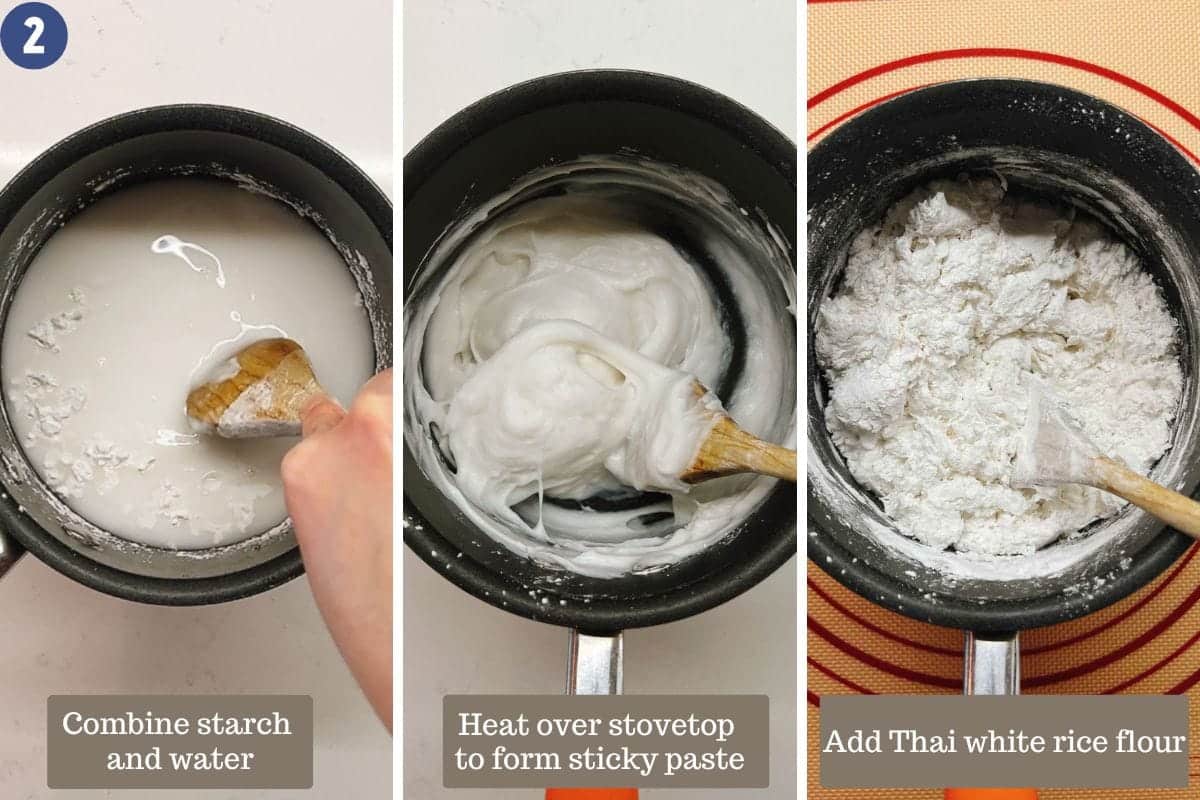
In a saucepan, dissolve salt in the water. Stir in the tapioca starch until fully combined. Cook over low heat, stirring constantly, until the liquid starts to thicken. Remove from heat and stir in the rice flour until incorporated. Transfer the dough to a silicone mat and scrape the pan to get all of the dough out.
- Knead the Dough

Knead oil into the dough for 5-6 minutes until smooth. If the dough seems crumbly, add 2-4ml warm water and knead for 1-2 more minutes. Cover the dough tightly with a large bowl and rest for 20 minutes.
- Roll Out Dough
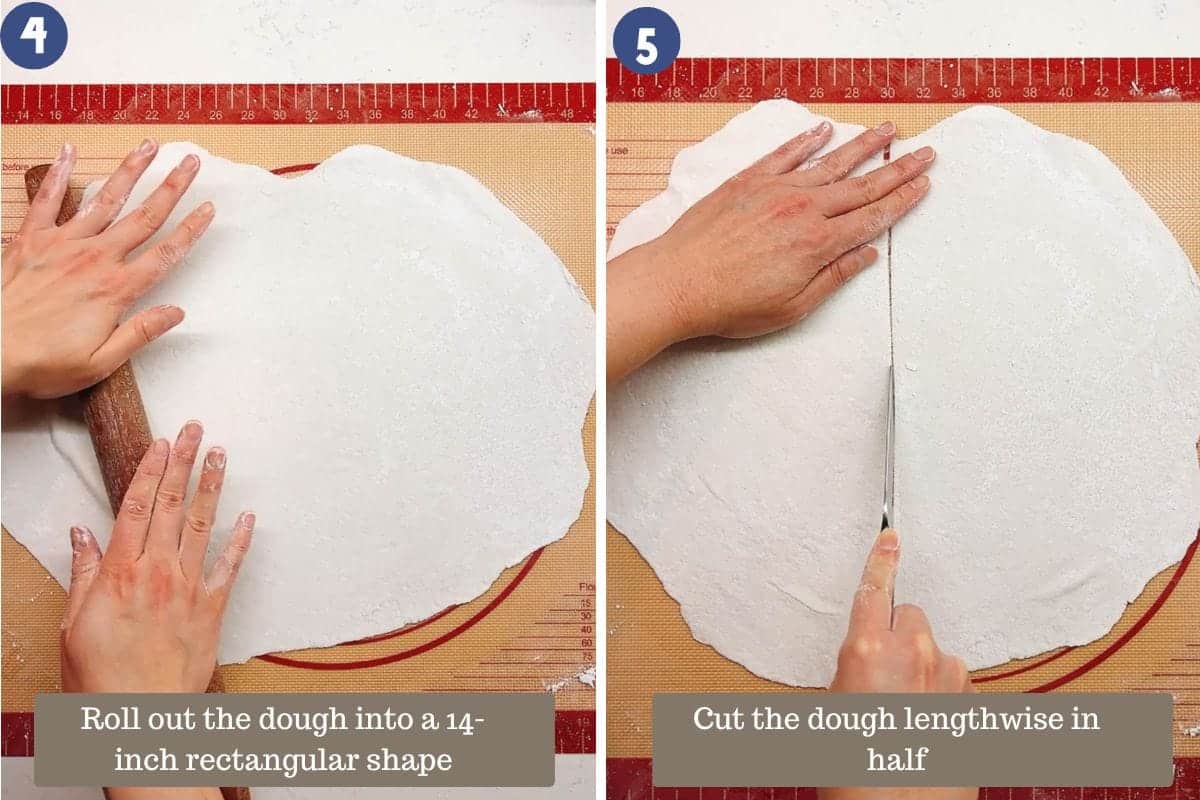
After resting, knead the dough for another minute. Dust a work surface lightly with rice flour. Roll the dough into a thin 14-inch rectangle roughly 2 mm thick, sprinkling with more flour if it gets sticky. Handle the dough gently to avoid tearing.
- Cut Wrappers

To cut the wrappers, first cut the dough lengthwise in half. Stack the rectangles and cut 3-inch wide strips using a butter knife or pastry cutter. Stack the strips, dusting them with flour between layers. Trim uneven edges then cut into 3-inch squares.
- Roll Thinner
For thinner wrappers, gently roll each square up to 3.5 inches. Work slowly to avoid tearing the dough.
Troubleshooting tips for GF wonton wrappers
Gluten-free doughs can be temperamental, even when following the recipe exactly. Here are some common issues and fixes:
- Dry, Crumbly Dough: If the dough won’t come together and feels too dry, add 2 ml warm water at a time while kneading. Add up to 4-6 ml total until the dough is workable. The finished dough should be slightly dry but stretchy.
- Wet, Sticky Dough: If a sticky dough forms with no elasticity, the measurements may be off, or extra ingredients may have been added. Unfortunately, a wet dough without stretchiness and structure is challenging to salvage. For best results, it’s better to start over or try making the recipe again another day.
- Through my own experiments and testing, I’ve found that some days the dough comes together easily, while other days the same recipe produces different results.
- When the dough lacks enough stretchiness and elasticity, it can be difficult to use it to wrap dumplings because the wrapper tears apart easily. In this case, you can salvage the dough by making wonton chips instead.
- Avoid Over-Kneading: While hydrating dry dough, don’t knead excessively or it will get too elastic. Knead just until combined to maintain stretch.
- Varying Kitchen Conditions; Temperature, humidity, altitude, etc. can affect dough hydration needs. You may need to tweak water amounts based on your environment.
How to make ahead, store, and cook
Use this dough to make gluten free wontons or gluten-free dumplings right away. The fresh dough has the ideal moisture level and thus is most pliable and easy to fold. Whether you’re making pork or vegan dumplings, gluten free wonton soup, or gyoza, make your filling ahead of time to have it ready.
- Make-ahead: I recommend making the wonton filling a day ahead and storing it in an airtight container in the refrigerator. Be sure to check out our wonton filling ideas (coming soon)!
- Using and Storing the Wonton Wrappers:
- It’s best to wrap the homemade wrappers into wontons right away. Once the wontons are formed, you can refrigerate them to use the next day or freeze them for up to 1 month and cook directly from frozen to eliminate prep time. Learn how to fold wontons here.
- Do not refrigerate or freeze the wrappers without first wrapping them into wontons. The unwrapped wrappers will become dry and crumbly, making them difficult to fold.
- How to freeze gluten-free wontons:
Once wrapped into wontons, arrange them in a single layer on a baking sheet. Flash freeze for 1 hour until solid. Then transfer the frozen wontons to a freezer-friendly bag and store them in the freezer for up to 1 month. - How to cook fresh and frozen wontons:
These cooking times are based on using 1 to 1.5 tsp of filling per wonton.- For fresh wontons: Bring water to a boil then lower to a simmer. Gently add the wontons and simmer for 5 minutes until cooked through. Use a slotted spoon to remove the cooked wontons.
- For frozen wontons: Cook directly from frozen. Bring water to a boil then lower to a simmer. Cook for 7 minutes total time.
How to use gluten free wonton wraps
A great alternative to traditional wonton wrappers made with wheat flour, these gluten-free homemade wrappers are extremely versatile. Here are some ways to enjoy them:
- Wontons – Moisten wrapper edges with water to seal in fillings for a gluten free wonton. Boil, steam or air fry the wontons until cooked through. Great for Gluten-free wonton soup, Wonton egg drop soup, Shrimp wonton soup, Shrimp wontons, Beef wontons, and more!
- Wonton Chips – Deep fry, air fry or bake plain or seasoned wrappers into crispy, crunchy wonton chips or gluten free wonton strips—perfect to sprinkle on soups or dip in sauces!!
- Wonton Cups – Lightly oil muffin tins and press the gluten free wonton skins in to form cup shapes. Bake at 350°F for 8-10 minutes. Fill with anything from chicken salad, sauteed bok choy, and cream cheese, to dessert fillings like apple pie.
- Gyoza Wrappers – Cut wrappers into rounds for gluten free gyoza. The wonton wrapper thickness is perfect for Japanese gluten free potstickers. Dip in gluten free soy sauce!
- Gluten Free Dumpling Wrappers – For gluten free dumplings, roll dough slightly thicker, about 3 mm.
- Egg Roll Wrappers – Cut wrappers into larger squares and fill for gluten free egg rolls.
Tips for success
- Use precise measurements. Follow the measurements exactly, especially for the water and flour. The specific amounts ensure the right dough texture. Weighing the ingredients is a must.
- Use recommended brands. For best results, use the exact rice flour and tapioca starch brands recommended (product links in the recipe). Different flours absorb moisture differently which affects measurements.
- Don’t over-knead. Knead just until the dough comes together smoothly, about 5-6 minutes. Avoid over-kneading or the dough will become too elastic and hard to stretch later.
- Use warm water. When making the dough, use warm rather than cold. Cold water can make the dough tough. Warm water helps keep the wrappers tender.
- Adjust water as needed. If the dough is dry, add warm water 2ml at a time while kneading until it comes together. The dough should be slightly dry and stretchy.
- Let the dough rest. After kneading, let the dough rest, covered, for 20 minutes. This allows the dough to absorb moisture and become smoother.
- Roll to 2mm thickness. Aim for paper-thin wrappers, about the thickness of a nickel (2mm). Thinner wrappers give the right delicate texture.
- Prevent sticking. Generously flour the work surface, dough roller, and wrappers while working to prevent sticking and tearing.
- Work quickly with homemade wrappers. Fill and cook the homemade wrappers soon after making them. They become dried out if refrigerated or frozen plain.
FAQs
Store-bought wonton wrappers are not gluten-free, as they contain wheat flour. However, homemade gluten-free wonton wrappers can be made using gluten-free flour like rice and tapioca flour. This recipe is also egg-free and dairy-free.
No, wonton wrappers do not need to contain eggs. Hong Kong styles use egg or food coloring for yellow color, while Shanghai styles are white and egg-free.
Currently, there are no store-bought brands for gluten-free wonton wrappers. Twin Marquis, Nasoya, and Twin Dragons wonton skins are not gluten-free. You can make your own gluten free won ton wrappers from scratch or use Vietnamese rice paper wrappers.
In a pinch, egg roll wrappers can be used for wontons. Keep in mind they are larger and thicker than wonton wrappers, so your final result may be different.
More dumplings and egg roll recipes you might like
If you feel inspired by this wonton wrap gluten free recipe, check out some of my other healthy Asian appetizers. They’re perfect for family-style meals or as party finger foods!
- Rice paper egg rolls with egg roll sauce: Gluten-free egg roll with sweet and tangy sauce.
- Rice paper dumplings: A faster alternative to making rice flour dumplings from dough.
- Daikon dumplings: Low-carb keto dumplings made with daikon slices.
- Keto shumai: Juicy keto meatballs wrapped in sweet cabbage leaves.

Gluten free wonton wrappers recipe
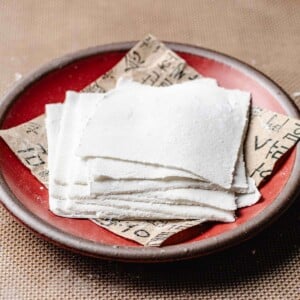
Video
Ingredients
Gluten free wonton wrappers:
- 80 ml room temperature water plus 4 ml warm water if needed
- 50 gram Bob’s red mill tapioca starch
- 50 gram Erawan Thai rice flour plus more for dusting
- 1/4 tsp coarse salt
- 2 tsp avocado oil or rice bran oil
- ½ tsp turmeric powder optional only if you want the wrappers in yellow color
Tools:
- A liquid measuring cup with milliliter quantity
- Large non-stick silicone pastry mat
- A rolling pin
- Weight scale
Instructions
Measuring and weighing:
- Use a liquid measuring cup to measure 80 ml of room temperature water. Make sure to check the measurement at eye level. You may also weigh the water on a scale to confirm it is 80 ml. Set aside an extra 4 ml of warm water in a small cup in case you need more later.
- Using a weight scale, measure 50 grams of tapioca starch into one bowl and 50 grams of rice flour into another bowl.
Form starch and add flour:
- In a medium saucepan, add the water and salt. Stir to dissolve the salt. Add the tapioca starch and use a wooden spoon to stir until there are no lumps.
- Place the pan over low heat on the stovetop. Stir constantly with the wooden spoon for about 2 minutes, until 2/3 of the liquid forms into lumps, about 2 minutes.
- Immediately remove the pan from the heat, but keep stirring for 5 more seconds then carefully add the rice flour to the pan. Stir to combine for 1 minute. Then, transfer the starch and flour mixture from the pan onto a large non-stick silicone pastry mat. Use the wooden spoon to scrape the pan a few times to remove all of the dough.
Form and knead the dough:
- Add the oil to the dough and knead for 5-6 minutes until thoroughly combined. The dough will seem bumpy at first. While kneading, make an indentation in the center of the dough and add some flour to the middle, then fold the dough over itself. Repeat this motion until the ingredients are fully incorporated. If desired, add turmeric powder now for yellow colored dough. At first the dough will seem crumbly and dry, but after 4 minutes of kneading it should start to come together. The finished dough should feel slightly dry and stretchy, which will help prevent the wrappers from tearing when rolling.
- If after 5 minutes the dough still seems crumbly and won’t fully combine, add 2 ml of warm water and knead for 1-2 more minute. If needed, add another 2 ml warm water and knead for 1-2 more minute. The dough should come together at this point. Avoid over-kneading or the dough will become too elastic and hard to stretch later.
- Cover the dough and let it rest at room temperature for 20 minutes. This rest time will help make the dough smoother.
Roll out the dough:
- After resting, knead the dough for 1 more minute to develop the elasticity. Lightly dust a work surface with rice flour to prevent sticking. Shape the dough into a rectangular log. Use a rolling pin to press down on the dough, obliquely twice in different directions. Then continue rolling out the dough into a thin rectangle about 14 inches long and 2 mm thickness (about a nickel thick). Try to maintain the rectangular shape as you roll. If any areas feel moist or sticky, sprinkle on more rice flour.
- The rolled out dough will feel smooth. Handle it gently to avoid tearing.
Cutting into wrappers:
- Dust the rolled out dough with more rice flour. Carefully cut the sheet in half lengthwise using a dough cutter or butter knife so you have two equal rectangles. Stack the rectangles on top of each other. Measure and cut one 3-inch wide strip from top to bottom. Use this strip to measure and cut another equal strips, so you have 4 long 3-inch wide strips total.
- Stack the 4 strips on top of each other, dusting with rice flour between each layer. Turn the strips horizontally. Trim off any uneven edges on one side to straighten. Measure and cut one 3-inch wide square. Use this square piece as a guide to cut the rest of the strips into equal 3-inch squares. You should get 12-14 wrappers.
Rolling Thinner (Optional):
- The wonton wrappers should be paper thin, almost translucent. If the wrappers are not thin enough, you can gently roll out each square further to reach the desired thinness, about 3.5 inches square, similar to store-bought wrappers. Work slowly and carefully to avoid tearing the dough.
Using and Storing the Wrappers:
- It’s best to use the homemade wrappers right after making them to wrap wontons. Once wrapped into wontons, you can refrigerate the wontons to use the next day or freeze them for up to 1 month and cook directly from frozen. Do not refrigerate or freeze the wrappers without first wrapping them into wontons. The unwrapped wrappers will become dry and crumbly, making them difficult to fold.
Notes
- Recipe adapted from by Lucy’s cooking channel (Youtube):
- How to measure water in cooking: https://shorturl.at/gvwDJ
- Is gram a volume unit or a weight unit? The metric system eliminates confusion because units are clearly defined. Grams always measure weight, while milliliters always measure volume. When you see grams mentioned, you know to use a scale. When you see milliliters, you know to use a liquid measuring cup.
- To double the recipe: I recommend weighing two equal sets of the recipe quantity and forming two separate doughs as opposed to lumping them into one for more accuracy.
- Troubleshooting tips for GF wonton wrappers:
- Gluten-free doughs can be temperamental, even when following the recipe exactly. Here are some common issues and fixes:
- Dry, Crumbly Dough: If the dough won’t come together and feels too dry, add 2 ml warm water at a time while kneading. Add up to 4-6 ml total until the dough is workable. The finished dough should be slightly dry but stretchy.
- Wet, Sticky Dough: If a sticky dough forms with no elasticity, the measurements may be off, or extra ingredients may have been added. Unfortunately, a wet dough without stretchiness and structure is challenging to salvage. For best results, it’s better to start over or try making the recipe again another day. When the dough lacks adequate elasticity, it can be difficult to use it to wrap dumplings because the wrapper tears apart easily. In this case, you can salvage the dough by making wonton chips instead.
- Avoid Over-Kneading: While hydrating dry dough, don’t knead excessively or it will get too elastic. Knead just until combined to maintain stretch.
- Varying Kitchen Conditions; Temperature, humidity, altitude, etc. can affect dough hydration needs. You may need to tweak water amounts based on your environment.
- Make-ahead: I recommend making the wonton filling a day ahead and storing it in an airtight container in the refrigerator. Be sure to check out our wonton filling ideas (coming soon)!
- Using and Storing the Wonton Wrappers:
- It’s best to wrap the homemade wrappers into wontons right away. Once the wontons are formed, you can refrigerate them to use the next day or freeze them for up to 1 month and cook directly from frozen to eliminate prep time. Learn how to fold wontons.
- Do not refrigerate or freeze the wrappers without first wrapping them into wontons. The unwrapped wrappers will become dry and crumbly, making them difficult to fold.
- How to freeze gluten-free wontons: Once wrapped into wontons, arrange them in a single layer on a baking sheet. Flash freeze for 1 hour until solid. Then transfer the frozen wontons to a freezer-friendly bag and store them in the freezer for up to 1 month.
- How to cook fresh and frozen wontons: These cooking times are based on using 1 to 1.5 tsp of filling per wonton.
- For fresh wontons: Bring water to a boil then lower to a simmer. Gently add the wontons and simmer for 5 minutes until cooked through. Use a slotted spoon to remove the cooked wontons.
- For frozen wontons: Cook directly from frozen. Bring water to a boil then lower to a simmer. Cook for 7 minutes.
- See our Shrimp wontons for more information and inspiration!
Nutrition
Nutrition information is automatically calculated, so should only be used as an approximation.
Made a dish and loved it? Please rate the recipe and leave a comment in the section below! It helps my blog grow organically, allowing me to continue sharing free and awesome content with you. Thank you!
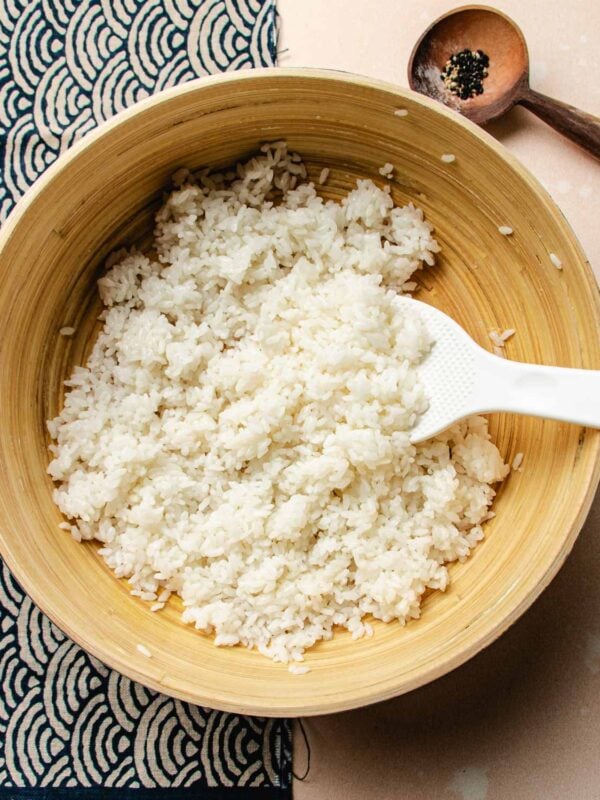

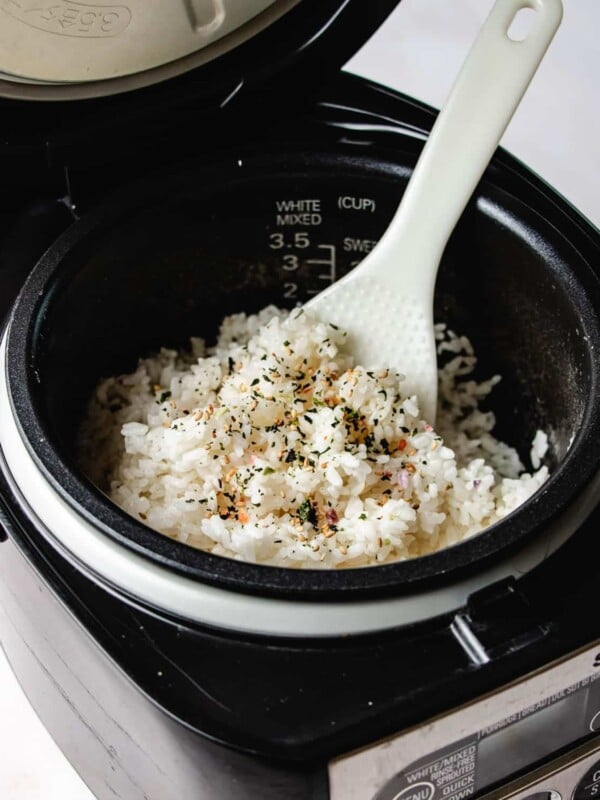
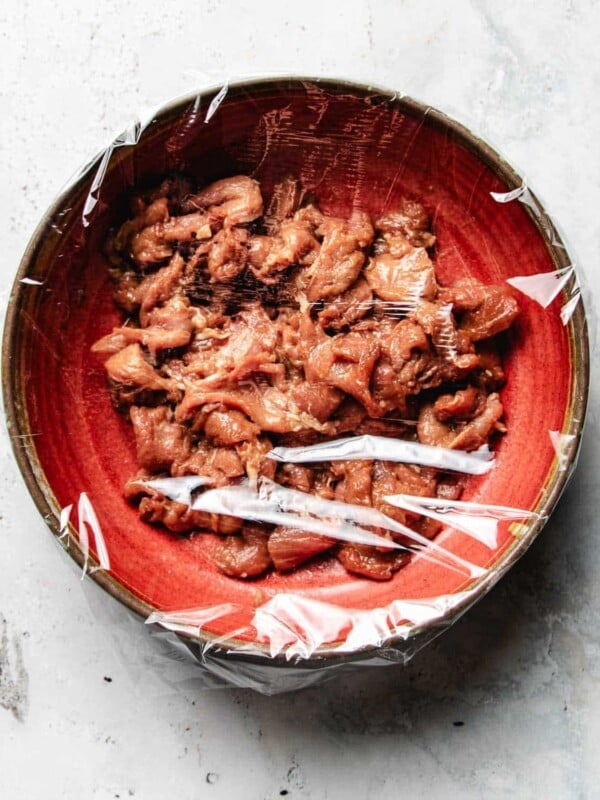









Do you think this recipe will work as egg roll wrappers? I’m wondering if they’re sturdy enough to fold and roll without falling apart.
Hi Sue, thanks for your message. I haven’t tried it yet for egg rolls but if you plan on frying them – the quick and direct heat from the hot oil – should keep the shape of the rolls well. Another alternative is to make smaller egg rolls so each roll is less heavy (in volume) and that should help, too. I also have a rice paper made egg rolls and people have been loving it – https://iheartumami.com/rice-paper-egg-rolls/
These wonton wrappers are super easy to make. I gathered the exact ingredients with the Thai white rice flour – got in my local Asian grocery store. It is a labor of love but the result is excellent! We made the beef wonton filling (also from the blog) and added then to soups. Now I have a large batch stored in the freezer for next time use. Thank you!
Can I use Erawan tapioca starch instead of Bob’s Red Mill? Anything Bob’s red mill is hard to find in Australia. But I can easily get Erawan brand.
Thanks, looking forward to trying to make these.
Yes! Erawan tapioca starch works, too!
Thank you. I’ll let you know how it goes making them. Hopefully mine will work as good as yours.😊
I get it Bob’s easily in IGA and Harris Farm